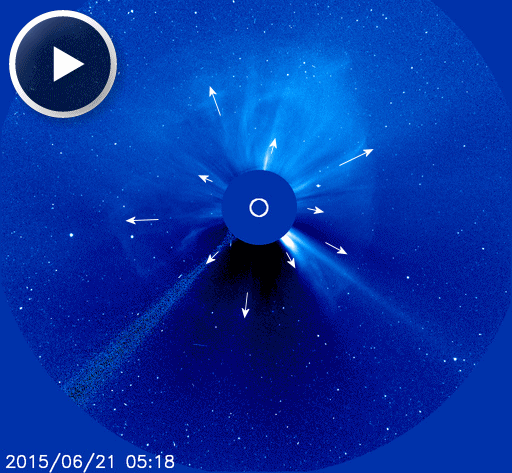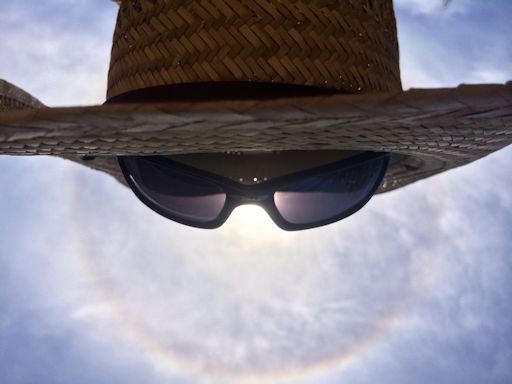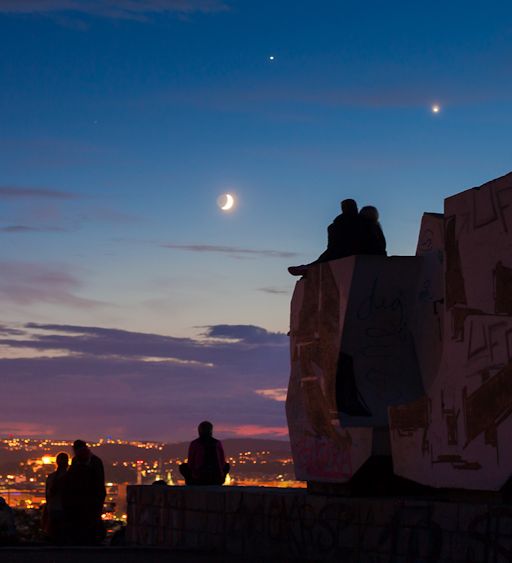Learn to photograph Northern Lights like a pro. Sign up for Peter Rosen's Aurora Photo Courses in Abisko National Park, winner of the TripAdvisor Certificate of Excellence Award 2015. | | |
CME IMPACT, MORE TO COME: A minor CME hit Earth's magnetic field on June 21st at approximately 1600 UT. The weak impact did not cause an immediate geomagnetic storm. At least two more CMEs are en route, including the full-halo CME described below. This means geomagnetic storms remain possible in the nights ahead despite the muted effect of today's strike. Aurora alerts: text, voice
FULL HALO CME: Sunspot AR2371 erupted on June 21st at 01:42 UT, producing an M2-class solar flare and a full-halo CME. Click to view a movie of the storm cloud, which is heading directly for Earth:

Geomagnetic storms are likely when the CME reaches Earth, probably on June 23rd or 24th. Its impact will add to that of two lesser CMEs already en route. NOAA analysts are modeling the full-halo CME now and, shortly, they will give their estimates for its arrival time and the severity of the resulting storm. Stay tuned for updates. Aurora alerts: text, voice
Realtime Aurora Photo Gallery
HAPPY SOLSTICE: Today is the June solstice--the longest day of the year in the northern hemisphere, and the shortest day in the south. The exact moment of the solstice is 12:38 pm EDT, when the sun reaches its highest declination on the celestial sphere (+23.5o). To mark the occasion, Richard Sears photographed this sun halo over Atwater, California:

"Happy solstice!" says Sears.
The long days of northern summer are excellent times to look for sun halos. They are formed by ice crystals in high cirrus clouds, which are freezing cold no matter how hot it gets on the ground below. Keep an eye on the solstice sun for rainbow-colored arcs in the surrounding sky.
Realtime Space Weather Photo Gallery
SUNSET SKY SHOW--IT'S NOT OVER YET: All weekend long, people around the world watched with pleasure as Venus, Jupiter, and the slender cresent Moon converged in the sunset sky. Pavel Gabzdyl photographed the triangular conjunction over Brno, Czech Republic:

"The three bright lights were visible even before the sun set," says Gabzdyl. "We could not take our eyes off of them."
As the new week unfolds, the Moon is moving away from the planets--but the show is far from over. In the evenings ahead, Venus and Jupiter will draw closer and closer to one another. On June 30th, they will be a jaw-dropping 1/3rd of a degree apart. You'll be able to hide the pair behind your little pinky finger outstretched at arm's length. Such a close pairing of bright planets is truly mesmerizing. Mark your calendar and enjoy the show!
Realtime Space Weather Photo Gallery
Realtime NLC Photo Gallery
Realtime Sprite Photo Gallery
Every night, a network of NASA all-sky cameras scans the skies above the United States for meteoritic fireballs. Automated software maintained by NASA's Meteoroid Environment Office calculates their orbits, velocity, penetration depth in Earth's atmosphere and many other characteristics. Daily results are presented here on Spaceweather.com.
On Jun. 19, 2015, the network reported 7 fireballs.
(7 sporadics)

In this diagram of the inner solar system, all of the fireball orbits intersect at a single point--Earth. The orbits are color-coded by velocity, from slow (red) to fast (blue). [Larger image] [movies]
Potentially Hazardous Asteroids (
PHAs) are space rocks larger than approximately 100m that can come closer to Earth than 0.05 AU. None of the known PHAs is on a collision course with our planet, although astronomers are finding
new ones all the time.
On June 21, 2015 there were potentially hazardous asteroids.
Notes: LD means "Lunar Distance." 1 LD = 384,401 km, the distance between Earth and the Moon. 1 LD also equals 0.00256 AU. MAG is the visual magnitude of the asteroid on the date of closest approach. | | The official U.S. government space weather bureau |
| | The first place to look for information about sundogs, pillars, rainbows and related phenomena. |
| | Researchers call it a "Hubble for the sun." SDO is the most advanced solar observatory ever. |
| | 3D views of the sun from NASA's Solar and Terrestrial Relations Observatory |
| | Realtime and archival images of the Sun from SOHO. |
| | from the NOAA Space Environment Center |
| | the underlying science of space weather |
| | Web-based high school science course with free enrollment |

